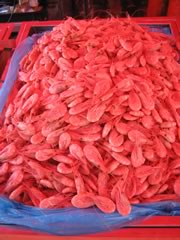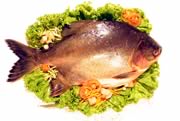Dieser Artikel ist noch nicht auf Deutsch vorhanden
Frozen processed fish/moulded fish products/fish fingers
Frozen processed fish/moulded fish products/fish fingers
During processing frozen fish blocks (layered fillets, jumbled or minced) are first cut into the required dimensions. With moulded products, the fish off-cuts, seasoning and binding materials are fed into a moulding machine and formed into the required shape. The product then passes through a series of enrobing machines, which cover the fish with batter and/or breadcrumbs, with the type and number of enrobers is depending upon the desired product. After enrobing the product is fried in an edible oil; temperatures vary but around 190 °C is typical. The fryers may be heated by thermal oil, gas or by electrical means. The fried product then travels into a freezing unit where it is subjected to a stream of cold air to reduce the product to a predetermined target temperature (-18 °C being typical).
Canned fish/shellfish products
Raw fish are washed, cut into fillets and then steamed in cooking/cooling tunnels. De-scaling is sometimes achieved using caustic baths. After steaming, the fish are filled into cans, which contain either brine, oil or sauce. The cans are sealed by passage through a can seamer. After seaming, the cans pass into a retort for sterilisation. Here the product is heated for at a sufficient temperature to inactivate any food poisoning micro-organisms. The product is then cooled with chlorinated water. Shellfish are processed in a similar manner but are often transported under a rocking motion through a scalding system to open the shells and dislodge the flesh. Additional washing and trimming steps may also be incorporated to remove sand and mud.

 Nach oben
Nach oben


 Firmen
Firmen


